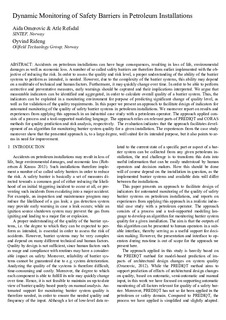| dc.contributor.author | Omerovic, Aida | |
| dc.contributor.author | Refsdal, Atle | |
| dc.contributor.author | Rideng, Øyvind | |
| dc.date.accessioned | 2017-10-27T12:29:23Z | |
| dc.date.available | 2017-10-27T12:29:23Z | |
| dc.date.created | 2013-10-17T16:33:40Z | |
| dc.date.issued | 2014 | |
| dc.identifier.citation | Safety, reliability and risk analysis : beyond the horizon : proceedings of the European Safety and Reliability Conference, ESREL 2013, Amsterdam, the Netherlands, 29 September-2 October 2013, 1707-1717 | nb_NO |
| dc.identifier.isbn | 978-1-138-00123-7 | |
| dc.identifier.uri | http://hdl.handle.net/11250/2462606 | |
| dc.description.abstract | Accidents on petroleum installations can have huge consequences, resulting in loss of life, environmental damages as well as economic loss. A number of so called safety barriers are therefore from earlier implemented with the objective of reducing the risk. In order to assess the quality and risk level, a proper understanding of the ability of the barrier systems to perform as intended, is needed. However, due to the complexity of the barrier systems, this ability may depend on a multitude of technical and human factors. Furthermore, it may quickly change over time. In order to be able to perform corrective and preventative measures, early warnings should be captured and their implications interpreted. We argue that measurable indicators can be identified and aggregated, in order to calculate overall quality of a barrier system. Thus, the indicators can be exploited in a monitoring environment for purpose of predicting significant change of quality level, as well as for validation of the quality requirements. In this paper we present an approach to facilitate design of indicators for automated monitoring of the quality of safety barrier systems in petroleum installations. We moreover report on results and experiences from applying this approach in an industrial case study with a petroleum operator. The approach applied consists of a process and a tool-supported modeling language. The approach relies on relevant parts of PREDIQT and CORAS methods for quality prediction and risk analysis, respectively. The evaluation indicates that the approach facilitates development of an algorithm for monitoring barrier system quality for a given installation. The experiences from the case study moreover show that the presented approach is, to a large degree, well suited for its intended purpose, but it also points to areas in need for improvement. | nb_NO |
| dc.language.iso | eng | nb_NO |
| dc.relation.ispartof | Safety, reliability and risk analysis : beyond the horizon : proceedings of the European Safety and Reliability Conference, ESREL 2013, Amsterdam, the Netherlands, 29 September-2 October 2013 | |
| dc.rights | Attribution-NonCommercial-NoDerivatives 4.0 Internasjonal | * |
| dc.rights.uri | http://creativecommons.org/licenses/by-nc-nd/4.0/deed.no | * |
| dc.title | Dynamic monitoring of safety barriers in petroleum installations | nb_NO |
| dc.type | Chapter | nb_NO |
| dc.description.version | acceptedVersion | nb_NO |
| dc.source.pagenumber | 1707-1717 | nb_NO |
| dc.identifier.cristin | 1058550 | |
| dc.relation.project | Norges forskningsråd: 217213 | nb_NO |
| cristin.unitcode | 7401,90,12,0 | |
| cristin.unitname | Nettbaserte systemer og tjenester | |
| cristin.ispublished | true | |
| cristin.fulltext | postprint | |
| cristin.qualitycode | 1 | |

